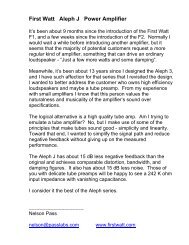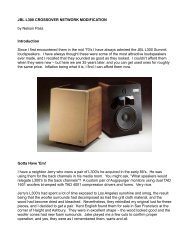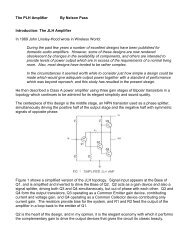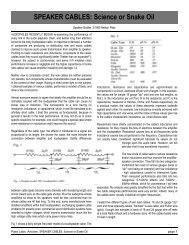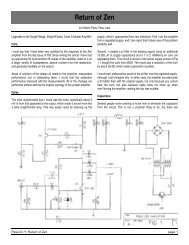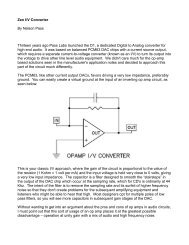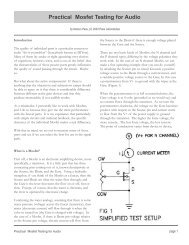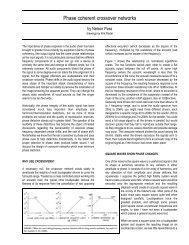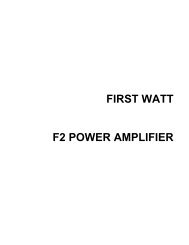The Legend of EL PIPE-O - First Watt
The Legend of EL PIPE-O - First Watt
The Legend of EL PIPE-O - First Watt
- No tags were found...
Create successful ePaper yourself
Turn your PDF publications into a flip-book with our unique Google optimized e-Paper software.
<strong>The</strong> <strong>Legend</strong> <strong>of</strong> <strong>EL</strong> <strong>PIPE</strong>-OBy Kent English and Nelson Pass, (c) 2002 Pass LabsIntroMost wo<strong>of</strong>ers just don’t quite do the lowest octave. Youread the specs that say “usable response: 20 Hz – 20KHz” and you know that the 20 Hz part <strong>of</strong> it is wildlyoptimistic. Achieving very low frequencies at reasonablepower levels is not an easy job; the acoustic impedanceexperienced by a speaker cone declines as the inverse<strong>of</strong> the square <strong>of</strong> the frequency. As a practical matter,wo<strong>of</strong>ers and their enclosures need to be very large toproperly reproduce the lowest octave. Even whenyou compensate with frequency equalization and moreamplifier power, the performance suffers as you reachthe excursion and power handling limitations <strong>of</strong> a smallcone in a small box.Let’s face it. Size does matter.This is the saga <strong>of</strong> El Pipe-O, an adventure in over-theedgewo<strong>of</strong>er construction. <strong>The</strong> name El Pipe-O camefrom its striking resemblance to a legendary smokingappliance belonging to one <strong>of</strong> Pass’s roommates incollege that was the object <strong>of</strong> worship by a small cult.is used to damp out this uncontrolled motion and turn itto getting a little more bass out <strong>of</strong> the speaker. <strong>The</strong> twomost popular approaches are the bass-reflex enclosureand the transmission line.<strong>The</strong> bass-reflex enclosure has the wo<strong>of</strong>er mounted in abox that has a specific internal volume and an openingto the outside. Any box with an opening has its ownacoustic resonance, known as Helmholtz resonance,which you experience when you blow into the opening<strong>of</strong> a beer bottle. Varying the volume <strong>of</strong> the box orthe size <strong>of</strong> the opening (called the port) adjusts thefrequency <strong>of</strong> resonance, and you can tune it to the samefrequency as the resonance <strong>of</strong> the wo<strong>of</strong>er.When the box’s resonance is the same as the wo<strong>of</strong>er’sresonance, you get an interesting effect: <strong>The</strong> wo<strong>of</strong>erexperiences acoustic loading which damps out itsuncontrolled motion and the port delivers extra acousticoutput to the outside world. <strong>The</strong> performance improvesbecause the cone moves less and the output is boostedat the lowest frequencies. This can be seen in theimpedance curves <strong>of</strong> figure 1. <strong>The</strong> impedance <strong>of</strong> theEl Pipe-O consists <strong>of</strong> very largewo<strong>of</strong>ers mated to large cylindricaltransmission lines. <strong>The</strong> goal is to getgood powerful response down to 20 Hzat levels where the room starts to rattlebefore the loudspeaker.Bass Reflex EnclosuresSuspended by elastic material, wo<strong>of</strong>ercones have a natural fundamentalresonant frequency at which the motionincreases dramatically, and below whichthe response drops <strong>of</strong>f at a sharp rate.Many wo<strong>of</strong>er enclosures attempt to setup some sort <strong>of</strong> counter-resonance thatFig. 1Pass D.I.Y Project: El Pipe-Opage 1
out <strong>of</strong> phase with each other, so that high pressuredevelops at the closed end where motion is notfavored, and high air motion occurs at the open end,where it can flow easily to the outside and no wallfavors the buildup <strong>of</strong> air pressure.Fig.2wo<strong>of</strong>er reflects the motion <strong>of</strong> the cone, and here we seea comparison between the wo<strong>of</strong>er’s impedance in free airversus its impedance in a tuned bass-reflex enclosure.Pipe DreamsA transmission line is a different approach to achievinga similar effect. In any tube shaped object, closed at oneend, a resonance develops at the frequency where thewavelength is four times the length <strong>of</strong> the tube. Thiseffect is exploited in numerous musical instruments,particularly the pipe organ.<strong>The</strong> wavelength <strong>of</strong> a frequency is thespeed the wave travels divided by thefrequency. For sound going throughair, that speed is approximately 1100 feetper second. At 20 Hz, the wavelength isabout 55 feet, and this is where a 14 foottube will resonate.This resonance is similar to that <strong>of</strong> the bass-reflexenclosure, and it has a similar effect. Figure 3shows the impedance <strong>of</strong> a wo<strong>of</strong>er in free air andin a transmission line tube tuned to the resonantfrequency. Like the bass-reflex, the transmissionline damps out the resonant motion <strong>of</strong> the cone,but it does it with a lower “Q”, or sharpness, sothat you tend to get a single bump instead <strong>of</strong> thedouble bump <strong>of</strong> Figure 1. Also like the bass-reflex,the output from the opening delivers more acousticenergy to the room, extending the response andpower at the lowest frequencies.Personally we favor a well-done transmission line overa bass-reflex enclosure. <strong>The</strong> bass is tighter and lessboomy, It also tends to extend deeper. Part <strong>of</strong> thiseffect comes from the actual lowering <strong>of</strong> the resonantfrequency <strong>of</strong> the wo<strong>of</strong>er due to the additional air mass ithas to push in the pipe.You can adjust the “Q” or sharpness <strong>of</strong> both the bassreflexand transmission line enclosures by stuffing themwith wool, Dacron, or fiberglass. <strong>The</strong> more fibrousmaterial you put in them, the more damped the effect.Resistive material <strong>of</strong> this sort also tends to increaseFig.3With a loudspeaker mounted at one end<strong>of</strong> the tube, essentially closing <strong>of</strong>f thatend, the mass and elasticity <strong>of</strong> the air inthe tube will cause a favored frequencywhere the tube is 1⁄4 the wavelength. InFigure 2 we see that at this frequency thepressure and air motion are 90 degreesPass D.I.Y Project: El Pipe-Opage 2
the apparent volume <strong>of</strong> the enclosure for a bass-reflexand the length <strong>of</strong> the enclosure for a transmission line.Choice <strong>of</strong> the density <strong>of</strong> this material is <strong>of</strong>ten left to thediscretion <strong>of</strong> the constructor, which the instructions,“Stuff to taste.”As with horns, the best transmission line is a straightone, with no bends. Bends compromise the effect, but<strong>of</strong>ten not so much that they still aren’t useful. Quite afew transmission lines have been designed which havebends in them in order to fit them into a reasonablespace. Figure 4 shows a couple <strong>of</strong> examples. <strong>The</strong>ywork well, exhibiting only minor compromise. Ourfavorite configuration is where the rear wave exits at therear near the floor. In this case, the floor adds someacoustic loading for greater output, and the opening ispointed away from the listener and is at some distancefrom the front <strong>of</strong> the wo<strong>of</strong>er. This approach minimizesinteraction between the wo<strong>of</strong>er’s front and rear wave athigher frequencies and also effectively adds a little lengthto the line.However, El Pipe-O is going to be a straight verticaltube, with the wo<strong>of</strong>er(s) at the bottom and the open end<strong>of</strong> the pipe at the top. It is not going to fit in an 8 foothigh listening room.Enter the SonotubeOf course we can built our transmission line any way welike out <strong>of</strong> wood, or those gigantic plastic storm draintype pipes, or even those monstrous concrete sewerpipes. Perhaps somewhere along the Alaskan pipeline isone happy audiophile, but we are going to do it the easyway; with Sonotubes.Sonotubes are heavy duty cardboard-typetubing used to cast concrete into pillars.<strong>The</strong>y are available in a number <strong>of</strong> diametersand lengths, and are generally available inmetropolitan areas. We usually buy them atWhite Cap stores, and we have played with 8inch, 14 inch, and 24 inch diameters. We getthem in 12 foot lengths, and the store willusually cut them to a desired length. If not,they, they are easy to cut with a saber saw.Oh yeah, and they are pretty cheap.Because they are cylindrical in shape, the tubes are verystrong, like eggs, for pressure which is equal aroundthe circumference <strong>of</strong> the tube, which is what they willexperience in a transmission line. Also, the fiber materialcomprising the walls is dense and fairly dead acoustically,making them a good choice.For this project we bought a pair <strong>of</strong> 12 foot long, 24inch diameter Sonotubes.<strong>The</strong> Wo<strong>of</strong>ersIf you read the MCM catalog ( www.mcmelectronics.com) then you’ve undoubtedly seen them. Part # 55-1835,Twenty-one inch Low Frequency Pro Wo<strong>of</strong>er. Eightohms, 96 dB at 1 watt, 25 Hz resonance, 200 watts rms,800 watts peak. Price: $395.Pass couldn’t help himself and bought four <strong>of</strong> them.<strong>The</strong>y sat around for a couple <strong>of</strong> years in boxes until wedecided to make El Pipe-O. In fact, El Pipe-O was theexcuse to use them up. <strong>The</strong>y look to be copies <strong>of</strong> a largeFocal wo<strong>of</strong>er, but the manufacturing quality is not quiteas high. If you buy these, we recommend that you testthem right away for voice coil mis-alignment. You cando this by pumping a low frequency signal into themwhile listening for scraping.ConstructionWe decided to use two wo<strong>of</strong>ers per side to maximize thecone surface area and power handling <strong>of</strong> each speaker.Boxes were constructed <strong>of</strong> MDF so that the wo<strong>of</strong>erswere mounted on adjacent sides and the sonotubes wereinserted from the top and were supported on the floorPass D.I.Y Project: El Pipe-Opage 3
Pass D.I.Y Project: El Pipe-Opage 4
Pass D.I.Y Project: El Pipe-Opage 5
Pass D.I.Y Project: El Pipe-Opage 6
Pass D.I.Y Project: El Pipe-Opage 7
ox opening and on the box floor, and silicone sealantwas used around the juncture <strong>of</strong> box and tube. <strong>The</strong>wo<strong>of</strong>ers were wired in parallel, to form 4 ohm loads oneach channel. <strong>The</strong> box was filled loosely with Dacronprior to mounting the wo<strong>of</strong>ers, and the wo<strong>of</strong>ers weremounted using lag bolts and string caulk.Finally the tubes themselves were filled with 20 lbs <strong>of</strong>Dacron each. Figures 11 and 12 are photographs <strong>of</strong> thefinished speakers.PerformanceFig. 11Fig.12<strong>of</strong> the box, with the sonotubes truncated at an anglethat provided a good opening between the tube and thebox.Figures 5 through 10 provide details <strong>of</strong> the constructionand dimensioning <strong>of</strong> the boxes and cuts. <strong>The</strong> usualspeaker construction techniques are appropriate,including the use <strong>of</strong> bracing and sealing materials.Because <strong>of</strong> the size and weight <strong>of</strong> the speakers, finalconstruction occurred at the spot where they were to beused. <strong>The</strong> tubes were mounted and glued in place at theFigure 13 shows the near field response curve <strong>of</strong> thedrivers without equalization or crossover filters, drivenat 1 watt (2.83 volts). Figure 14 shows the responsecurve <strong>of</strong> El Pipe-O at 1 meter away, where room effectscan start to be observed. Both curves are calibrated sothat 0 equals a 100 dB level.Like many big wo<strong>of</strong>ers, the response curve extends outto higher frequencies irregularly and with questionabletransient response. Also seen in the curves is the needfor some equalization to make the wo<strong>of</strong>er truly flat downto 20 Hz. No problem, we will simply make a crossoverfilter that accomplishes both requirements.Using a Pass XVR1 we set up, measured, and listenedto a wide variety <strong>of</strong> possible crossover filters; varyingfrequency, slope, and Q. Ultimately we settled on a 2 pole,22 Hz low pass filter as the best sounding compromise.Figure 15 shows the near field response with no filter, 1pole low pass (6 dB/octave) at 22 Hz, and the 2 pole lowpass (12 dB/octave) that we ended up using. Figure 16shows the response at 1 meter. Note that active filteringdoes not alter the sensitivity <strong>of</strong> the loudspeaker, whichranges from about 85 to 103 dB / watt.Pass’s listening room measures 30 ft by 30 ft, with a 14foot ceiling at the center. <strong>The</strong> height <strong>of</strong> El Pipe-O at12 feet mean that we were not able to play with cornerplacement, and we placed the speakers a few feet apartjust behind where speakers would ordinarily be placed,and allowing about 2 feet space between the pipeopenings and the ceiling.<strong>The</strong> final result (bottom curve) measures about +-3BPass D.I.Y Project: El Pipe-Opage 8
Fig. 13Fig. 14Pass D.I.Y Project: El Pipe-Opage 9
Fig. 15Fig. 16Pass D.I.Y Project: El Pipe-Opage 10
in the room from about 13 Hz to 75 Hz, and it goesaway rapidly enough at higher frequencies to avoid beingobnoxious. We evaluated the performance in systemsusing the Fostex 204 “full range” speaker, the TAD1101with a Raven R2 on the top, and (over time) a fairly widesampling <strong>of</strong> conventional speakers, none <strong>of</strong> which hada particularly strong bottom end.A very important consideration is the quality <strong>of</strong>transition from subwo<strong>of</strong>er to an ordinary wo<strong>of</strong>er; thephase and amplitude <strong>of</strong> the mixed response has to besmooth or it can sound pretty awful. If these aren’tright, the bass can get very boomy from peaks or sufferfrequency drop-outs that destroy the attack.Fortunately, El Pipe-O “plays well with others” as long asthere is not too much distance between the big wo<strong>of</strong>ersand the higher frequency drivers. We found that placingthe main speakers directly in front <strong>of</strong> the transmissionlines worked best.Active CrossoverFigure 17 shows an active op-amp type circuit thatdelivers the crossover filter characteristic we used, whichis a 2 pole low pass at 22 Hz. <strong>The</strong> tolerances are not atall critical, and just about any ordinary high quality gaincircuit will do.Passive Active CrossoverFigure 18 shows a “passive” circuit which is designedto be placed at the output <strong>of</strong> the amplifier driving themain speakers which filters and attenuates that signal forfeeding to the amplifier(s) driving El Pipe-O. As with theactive filter, the tolerances and such are not particularlycritical, but note that this circuit is not designed to bedriven by an amplifier with balanced outputs, whereboth output connections are “live”. It assumes theamplifier (-) connection is at ground, and also assumesthat the ground <strong>of</strong> the driving amplifier and the ground<strong>of</strong> the bass amplifier are at similar potentials (which theyusually are). If you wish to build just one El Pipe-O forboth channels, you can give each <strong>of</strong> the two wo<strong>of</strong>ers itsown crossover and amplifier, or you can mix inputs atthe input <strong>of</strong> the crossover, giving each channelits own input resistor with twice the resistancevalue shown in Figure 18.<strong>The</strong> SoundWell, <strong>of</strong> course this is the best part. <strong>First</strong> youhave to go through your record collectionlooking for material that goes down this low. Alot <strong>of</strong> nice sounding music doesn’t go below 40Hz or so, and if you listen to this material, youdon’t really get the impression that anythingparticularly special is happening.This is good, because we didn’t want thespeaker to <strong>of</strong>fer up a freak show <strong>of</strong> specialeffects where it’s not wanted; we want neutraland seamless performance in the upper bass.No, we wanted the freak show to be downPass D.I.Y Project: El Pipe-Opage 11
around 20 Hz.Movie soundtracks are a good source <strong>of</strong> this sort <strong>of</strong>thing: Jurassic Park or Dracula. Pink Floyd’s Dark Side<strong>of</strong> the Moon. You know what kind <strong>of</strong> records we’retalking about.Funny things happen when your speakers are flat to 13Hz. You have to be careful about your tone arm, yourwindows, your neighbors, and your bowels. After we gotthe system running, we spent a hour or so going aroundthe room bolting down or otherwise re-arranging knickknacks,shelving, furniture and windows that beganrattling. After that, we called up our friends and had alittle party. And another.each, and at the end <strong>of</strong> this event we were down to twowo<strong>of</strong>ers.ReconstructionRather than spend another $800 on wo<strong>of</strong>ers, we decidedto try single wo<strong>of</strong>ers on each side, so we took apartthe tubes and reconfigured them as 10 foot tubes witha wo<strong>of</strong>er at the bottom. We made a nice cylindricalcoupler out <strong>of</strong> MDF to mate the wo<strong>of</strong>er to the tube(Figure 19) and sat them on the wo<strong>of</strong>er’s magnet onblocks <strong>of</strong> granite (Figures 20 and 21). On top <strong>of</strong> the<strong>The</strong> Party Incident<strong>The</strong> first listening sessions were run with 100 wattamplifiers. Of course something like El Pipe-O callsfor monster amplifiers, so we acquired Pass X1000’s,which can do about 4,000 watts peak (per channel)into 4 ohms. <strong>The</strong> occasion <strong>of</strong> firing these up called foranother party, during which we drank a lot <strong>of</strong> Cabernetand then decided to test the power handling claims <strong>of</strong>the wo<strong>of</strong>er manufacturer.<strong>The</strong>se claims were fairly accurate at 800 watts peakFig. 20Fig. 21Pass D.I.Y Project: El Pipe-Opage 12
coupler, we placed some <strong>of</strong> the kind <strong>of</strong>plastic grid used in elevator lights to keepthe dacron from falling onto the wo<strong>of</strong>ercones. <strong>The</strong> tubes were stuffed the same,and we used the same crossover filter.Figure 22 shows the near field output<strong>of</strong> the single wo<strong>of</strong>er without the filters,which actually turned out a bit flatter thanthe twin driver models. Moving out intothe room at two meters we get Figure 23,and applying the filter we get Figure 24.Noting the differences between the twinand single wo<strong>of</strong>er versions, we see thatthe single wo<strong>of</strong>er gives flatter responseat frequencies above 20 Hz, but falls <strong>of</strong>fmore quickly below 20 Hz. Neverthelessit manages a respectable +-2 dB from 20to 80 Hz.Fig. 22<strong>The</strong> reconstructed version sounded aboutas good as the original, and probably givesa smoother transition to other speakers.It doesn’t have quite the same powerhandling and doesn’t go quite as low, butin our opinion, it ended up being a slightlymore elegant result.ConclusionExcept for the sheer scale <strong>of</strong> the endeavor,this was a remarkably easy project.Sonotubes make great transmission lines,and the vertical floor to ceiling approachis simple and effective. <strong>The</strong>y might betall, but the footprint is small, and maybeyour wife will let you keep them if youfinish them properly. If you have an 8foot ceiling, you can make two out <strong>of</strong> a12 foot piece <strong>of</strong> 8 inch diameter, and findyourself decent 8 inch wo<strong>of</strong>ers resonant atabout 40 Hz. <strong>The</strong>n you can start havingparties, too.Fig. 23Fig. 24Pass D.I.Y Project: El Pipe-Opage 13



